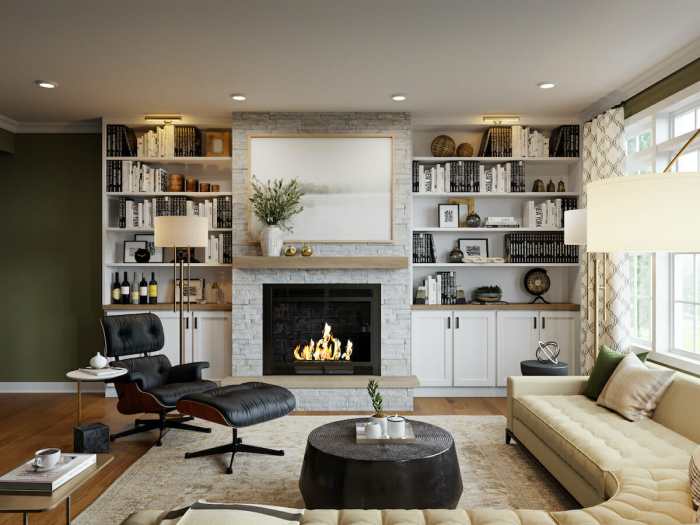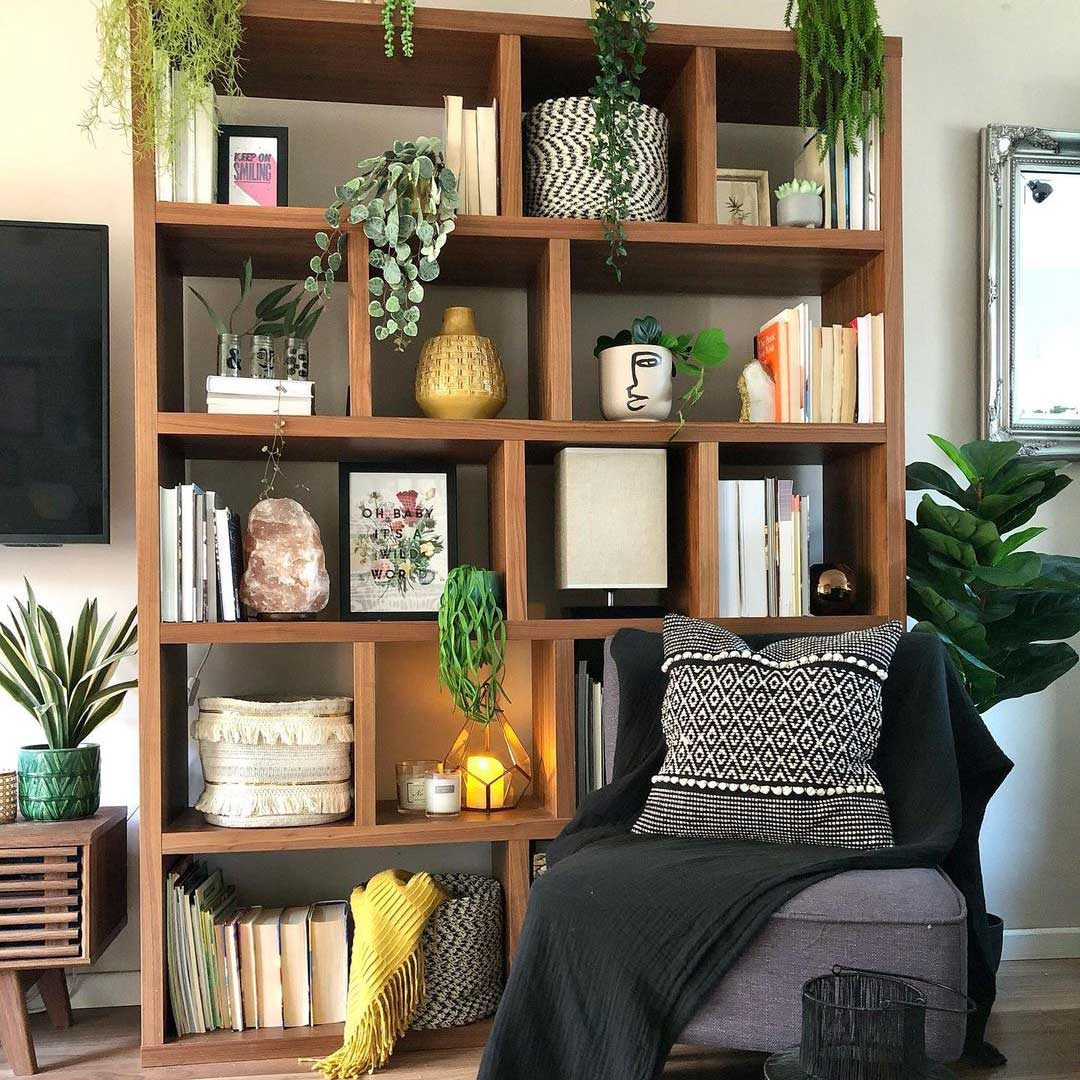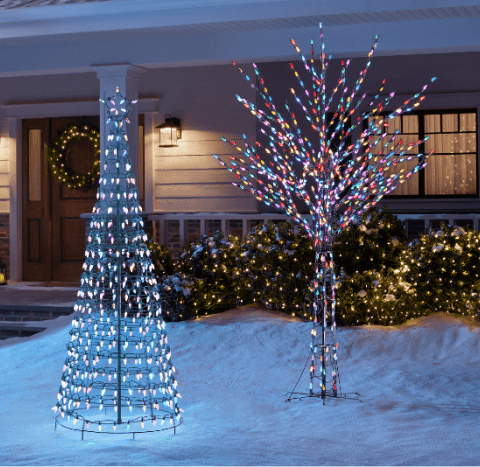Organizing Shelf Items

Ideas for shelf decor – A well-organized shelf is more than just a storage solution; it’s a curated display reflecting personal style and a carefully considered approach to visual harmony. Effective organization enhances both the aesthetic appeal and the functionality of your shelving, transforming a cluttered space into a pleasing and easily accessible area. The key lies in understanding principles of visual balance, utilizing vertical space creatively, and employing strategic decluttering techniques.
Three Organizational Systems for Books
Three distinct approaches can be adopted to arrange books on a shelf, each offering a unique blend of aesthetic and practical advantages. The first, chronological organization, arranges books by publication date, creating a visual timeline of reading or collecting habits. This method is particularly appealing for those with a deep interest in a specific author or genre. The second approach prioritizes color-coding, grouping books by similar cover colors to create a visually striking gradient or a harmonious palette.
So, you’re brainstorming shelf decor ideas, right? Maybe something a little less “grandma’s knick-knacks” and more… vibe. Think about incorporating natural elements, like seashells – it reminds me of those awesome beach wedding decor ideas I saw, super chill. You could even use driftwood or miniature sandcastles for a unique, beachy shelf aesthetic. Back to those shelves though, let’s get creative!
This system can transform a shelf into a vibrant work of art, highlighting the interplay of hues and shades. Finally, thematic organization groups books according to subject matter, creating distinct sections devoted to specific topics like travel, history, or fiction. This approach enhances accessibility and allows for a more intuitive browsing experience.
Arranging Items of Varying Sizes and Shapes
Achieving visual balance on a shelf involves a careful consideration of size, shape, and weight distribution. Larger, heavier items should generally be placed lower on the shelf to create a sense of stability and grounding. Smaller, lighter items can then be strategically positioned above or around them to add visual interest without disrupting the overall balance. The use of varied textures and materials also contributes to a more dynamic and engaging display.
For instance, a large, heavy ceramic vase could be balanced by a collection of smaller, lighter framed photographs. The contrast in size and texture prevents visual monotony and enhances the overall visual appeal.
Five Creative Uses of Vertical Space
Vertical space is often underutilized on shelves. Five methods maximize this often-overlooked dimension. First, use stacked books to create vertical columns, breaking up the monotony of a horizontal line. Second, incorporate tall, slender decorative objects like vases or candlesticks to draw the eye upwards. Third, utilize tiered trays or risers to add visual height and create distinct levels for displaying smaller items.
Fourth, install small floating shelves within larger shelves to create additional display areas. Finally, consider using vertical dividers or bookends to segment the shelf into distinct zones, creating visual interest and facilitating organization.
Decluttering and Organizing a Shelf: A Step-by-Step Guide, Ideas for shelf decor
Decluttering and organizing a shelf requires a methodical approach. First, empty the entire shelf, creating a clean slate. Second, assess each item individually, deciding whether to keep, donate, or discard. Third, group similar items together – books by genre, decorative objects by style, etc. – creating cohesive clusters.
Fourth, arrange the items on the shelf, considering size, shape, color, and texture to create visual balance and a pleasing aesthetic. Fifth, step back and assess the overall arrangement, making adjustments as needed to achieve the desired look and functionality. This systematic process ensures a visually appealing and well-organized shelf.
Decorative Elements

The artful arrangement of decorative elements elevates a shelf from mere storage to a captivating display. Careful consideration of plant life, unique objects, and strategic lighting can transform a simple shelf into a focal point, reflecting personal style and adding visual warmth to any space. The key is balance—a harmonious blend of textures, colors, and heights that creates a pleasing aesthetic.
Plants and Flowers as Shelf Decor
Plants and flowers introduce life and vibrancy to shelf displays. Succulents, with their low-maintenance nature and diverse forms, are ideal for shelves, thriving in bright, indirect light. Trailing pothos or ivy can cascade gracefully from higher shelves, adding a touch of lush greenery. Small orchids, in their elegant pots, provide a sophisticated touch. Placement is crucial; larger plants should anchor the display, while smaller ones can fill in gaps and add visual interest.
Avoid overcrowding; allow space for each plant to breathe and showcase its unique qualities. Consider varying heights and textures for a dynamic composition.
Five Unique and Inexpensive Decorative Items
Five inexpensive yet unique items can significantly enhance shelf styling. A vintage book, opened to a captivating illustration, adds a touch of literary charm. A collection of small, colorful glass bottles or jars can create a visually interesting grouping. A hand-painted ceramic tile, perhaps depicting a landscape or abstract design, introduces texture and artistry. A small, intricately carved wooden box adds a sense of history and craftsmanship.
Finally, a selection of dried flowers, arranged in a simple vase, provides a touch of natural beauty that endures.
The Impact of Lighting on Shelf Displays
Lighting plays a pivotal role in showcasing shelf displays. A strategically placed LED strip light, positioned behind the shelf, creates a dramatic backlighting effect, highlighting the objects and adding depth. Small, battery-operated fairy lights can add a whimsical, magical ambiance, particularly effective for shelves showcasing delicate items or creating a cozy atmosphere. A small table lamp, positioned near the shelf, can provide focused illumination, drawing attention to specific items and enhancing their details.
The choice of lighting depends on the desired mood and the overall aesthetic of the room. Warm-toned lighting generally creates a more inviting atmosphere, while cooler tones offer a more modern feel.
Ten Decorative Elements for Visual Interest
A thoughtfully curated collection of decorative elements significantly enhances visual appeal.
- Vintage Photographs: Black and white photographs in ornate frames add a nostalgic touch.
- Small Sculptures: Miniature sculptures, whether ceramic, wood, or metal, introduce artistic elements.
- Candles: Scented candles in attractive holders add fragrance and ambiance.
- Crystals: Clear or colored crystals catch and refract light, adding sparkle.
- Seashells: A collection of seashells evokes memories of the ocean and adds a natural texture.
- Books: Stacking books of varying sizes and colors creates visual interest and adds height.
- Artwork Prints: Small, framed prints of artwork or photography introduce color and personal style.
- Travel Souvenirs: Meaningful travel souvenirs add personal touches and storytelling elements.
- Pottery: Small, handcrafted pottery pieces introduce texture and artistry.
- Figurines: Small figurines, whether animal or human, add personality and charm.
Frequently Asked Questions: Ideas For Shelf Decor
What is the best way to arrange books on a shelf?
Consider arranging books by color, size, or genre for a visually appealing and organized look. Mix vertical and horizontal stacks for visual interest.
How can I add lighting to my shelf display?
Use small LED strip lights, puck lights, or even a strategically placed table lamp to highlight your items and create a warm ambiance.
What are some inexpensive decorative items for shelves?
Repurposed jars, vintage books, framed photos, small plants, and candles are affordable and effective options.
How do I choose a color palette for my shelf decor?
Select a color scheme that complements your room’s overall decor. Consider using analogous colors for a cohesive look or complementary colors for a more vibrant effect.







